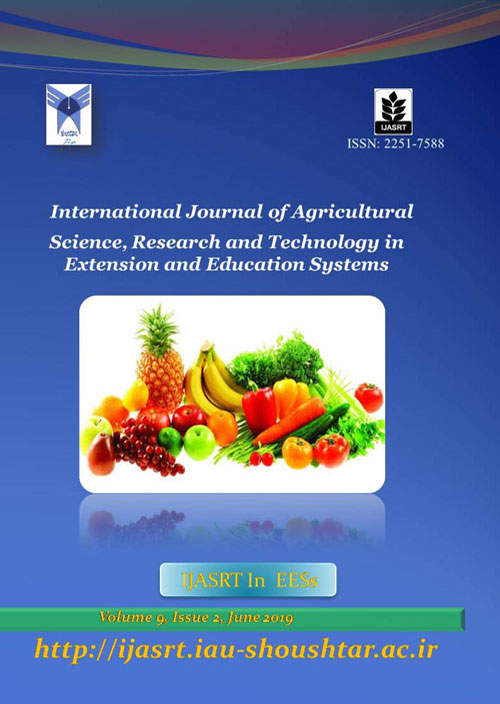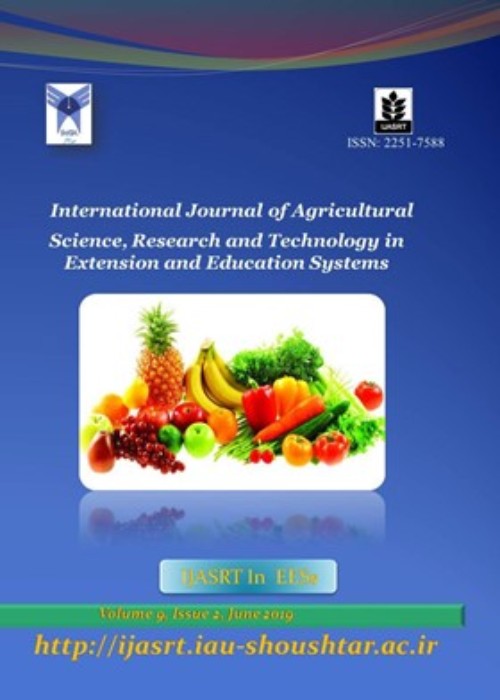فهرست مطالب

International Journal of Agricultural Science Research and Technology in Extension and Education Systems
Volume:12 Issue: 3, Sep 2022
- تاریخ انتشار: 1401/08/21
- تعداد عناوین: 6
-
Pages 119-126
Women are one of the most important factors in maintaining economic prosperity and the stability of society. Women's employment is an important part of any country's economy. Women have a valuable place in Islam. The main purpose of this study is to investigate the role of women's employment in the economy and family rights. This research has been done in the form of content analysis and qualitative study of grounded theory in an exploratory way. The role of women in the home economy was done in the form of 3 stages of open coding, axial coding and selective coding. According to the research results, the most important roles of women in the economy and family rights in rural society include economic productivity, processing and packaging, economic efficiency and production. Therefore, paying attention to the important role of women in economic development and ultimately sustainable development will pave the way for the flourishing of the capabilities of this important sector in society.
Keywords: Women, Employment, Economy, family rights, Qualitative study -
Pages 127-137Climate poses challenges to the health and productivity of the populace. It is against this background that the study examined the effect of climate change and health on farmers’ productivity in Southwest Nigeria. The research dwelt on cross-sectional data gathered through a structured questionnaire and a personal interview. A multistage sampling method was used to select 450 respondents at a random. Descriptive statistics and the Stochastic Frontier Production Function were used to analyse the data. The findings of the inefficiency component revealed that education, catastrophic health payment status, access to healthcare services, and adoption of adaptation measures were the most important determinants of farmer technical efficiency, with unhealthy days reducing farmer technical efficiency. The average technical efficiency value was 0.73, while the total elasticity coefficient was 1.27. It showed that food production was still operated in stage I (increasing RTS) of the production surface. Therefore, in designing sustainable agricultural development that will promote economic performance, policymakers need to incorporate health and climate adaptation measures into the production system to get optimum output in the study area.Keywords: Adaptation, Constraints, Productivity, stochastic frontier
-
Pages 139-149
This paper examined safety in agricultural extension and development in Cross River State, Nigeria. It reviewed literature on unsafe behavior in agricultural extension and development, assess unsafe environment in agricultural extension and development, examine the common hazards in agriculture, review the importance of safety in agricultural development and assess safety constraints in agricultural extension and development. The paper observed that; improper clothing, emergency preparedness, field operations, and livestock handling were some of the aspects where farmer’s activities needed more safety attention in the study area. Also the paper noted that certain activities and conditions influence safety in agricultural extension and development in Cross River State such as; poor handling of animals, Confined Spaces, Heights, Machinery, Noise Pollution, Vehicles, Water, and Weather. Common hazards reviewed were dangers originating from agricultural machinery such as tractor, implement or tools, hazardous chemicals, toxic or allergenic agents, carcinogenic substances, transmissible animal diseases, ergonomic hazards, and extreme temperatures while safety constraints in agricultural extension included macro-contextual factors and institutional contextual factors. The study recommended that the level of hazards emanating from agricultural operations be determined and evaluated, while also ensuring the implementation of zero hazardous practices in the Nigerian agriculture. The study conclude that safety is crucial for agricultural development, as accident and hazards are the products of negligence and avoidance of the extra effort or cost of carrying out farm activities.
Keywords: safety, Agricultural extension, extension, development -
Pages 151-158The purpose of this research is to analyzing people's attitudes to traditional methods of retaliation in resolving ethnic conflicts between nomads and villagers and the required cultural extension and education, Iran through qualitative method. To achieve the objectives of the research, semi-structured interviews and brainstorming techniques were used to collect data, and triangulation was used to evaluate the validity of qualitative findings. In order to implement the qualitative method, three types of open, axial and selective coding were used. MAXqda12 software was used to analyze the collected data. Based on qualitative analysis, 21 initial codes with 257 repetitions with 12 sub-categories in 4 main categories of culture building in reducing conflicts, paying attention to religious traditions in solving ethnic conflicts, paying attention to the views and opinions of tribal elders and holding educational and extension courses in the development of participation and social and cultural interactions were identified. By considering the results of this research, cultural affairs planners can aim to reduce conflicts and the number of court cases.Keywords: Attitude, ethnic conflicts, Nomads, Villagers, extension, education, Iran
-
Pages 159-165The role of women in agricultural production in Nigeria can never be underestimated. Male dominance in decision making in the household and economy as well as agricultural production has continued even in areas where women are the key providers. The study was carried out to analyze the influence of household decision making on vegetable farming among rural women in Kwara state, Nigeria. One hundred and twenty women vegetable farmers were randomly selected from four local government areas in twelve villages across two Agricultural Development Programme Zones in Kwara state. The primary data were collected with the use of structured questionnaire through interview schedule. Both descriptive and inferential statistics were used to analyze the data. The results showed that only few (9.17%) of the women have control over land. Interestingly, unlike land, a large number (71.67%) of the women have access and control over farm inputs such as fertilizer, insecticides etc. Unfortunately, none of the women have access to credit and only 38% of the women have access to extension information. Conclusively, women have limited individual influence on household decision making. However, they have a high level of participation in joint decision making with their husbands and children.Keywords: Vegetable, rural, Women, decision, Nigeria
-
Pages 167-177Comparative study on the impact of Rural Finance Institution Building Programme (RUFIN) on the food security status of the beneficiaries and non-beneficiaries was conducted in Anambra State, Nigeria. The study employed multistage, purposive and snowball sampling techniques to select 120 households (60 beneficiaries and 60 non-beneficiaries). Data were collected using structured interview schedule. To determine the food security status of the RUFIN beneficiaries (RB) and non-beneficiaries (NRB), food security survey module was adopted. Descriptive statistics, t-test and factor analysis were used for data analysis. About 43% of RB and 22% of NRB were food secured. No significant (p>0.05) difference was seen between the two groups in the number of times households feed in a day (t = 0.00) with food insecurity score of t = -1.53. Conclusively, beneficiaries were more food secured than the non-beneficiaries but the marginal difference is not so substantial when viewed in the lens of the programme intention. Therefore, the volume of loanable amount and payback period should be increased by RUFIN to allow for meaningful agricultural investment which will in a long run, positively affect the food security status of the beneficiariesKeywords: RUFIN, Impact evaluation, Food Security, strategies


